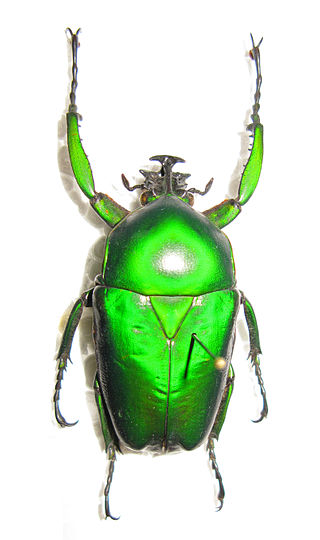
The sap beetles, also known as Nitidulidae, are a family of beetles.

Tiger beetles are a family of beetles, Cicindelidae, known for their aggressive predatory habits and running speed. The fastest known species of tiger beetle, Rivacindela hudsoni, can run at a speed of 9 km/h, or about 125 body lengths per second. As of 2005, about 2,600 species and subspecies were known, with the richest diversity in the Oriental (Indo-Malayan) region, followed by the Neotropics. While historically treated as a subfamily of ground beetles (Carabidae) under the name Cicindelinae, several studies since 2020 indicated that they should be treated as a family, the Cicindelidae, which are a sister group to Carabidae within the Adephaga.

Darkling beetle is the common name for members of the beetle family Tenebrionidae, comprising over 20,000 species in a cosmopolitan distribution.

Flower chafers are a group of scarab beetles comprising the subfamily Cetoniinae. Many species are diurnal and visit flowers for pollen and nectar, or to browse on the petals. Some species also feed on fruit. The group is also called fruit and flower chafers, flower beetles and flower scarabs. There are around 4,000 species, many of them still undescribed.

Goliathus regius, the Royal Goliath beetle, is a species of beetles of the family Scarabaeidae.

The red-headed weaver is a species of bird in the family Ploceidae. It is placed in the monotypic genus Anaplectes and is found throughout the Afrotropics.

Badister is a genus of ground beetle in the family Carabidae native to North Africa, the Near East, and the Holarctic, including Europe.

Narycius opalus is a flower chafer beetle that is endemic to the Western Ghats of India. It is the sole species in the genus. The adult male has a prominent projection on the head, while the female has a much shorter horn. This structure is probably the result of sexual selection, as in similar beetles. The adult beetle is shiny iridescent rose ranging to green, with intermediates.

The western Hercules beetle is a species of rhinoceros beetle that lives in Arizona, New Mexico and Utah in the United States and in parts of northern Mexico. This species is known for its grayish-white elytra, large size, and characteristic horn of the adult males.

Cyclommatus is a genus of the family Lucanidae, also known as the stag beetle. The majority of the species from the genus Cyclommatus are located in Southeast Asia, though some species are found in China and Taiwan as well. The genus Cyclommatus also consists of three subgenera: Cyclommatus, Cyclommatinus and Cyclommatellus. Each subgenera contains 80, 24 and 3 species respectively. In total, the genus Cyclommatus consists of a total of 134 species, though more are still being discovered to this day.

Dicronorhina derbyana, or Derby's flower beetle, is a sub-Saharan species of flower chafer.

Dicronorhina micans is a species of beetle of the family Scarabaeidae and subfamily Cetoniinae. It is native to the African tropics.

Scelophysa trimeni, commonly known as the blue monkey beetle, is a species of scarab beetles in the tribe Hopliini, subfamily Melolonthinae.

Inca clathratus is a species of flower chafer in the family Scarabaeidae, indigenous to Central and South America. These beetles can be seen surrounding the sap flows from injured or diseased trees anytime in the day and sometimes at night. They mostly feed at the sap flows of the trees, including avocado and mango trees. Like other beetles they also feed off of rotting fruit. There are a few different subspecies of Inca clathratus including: Inca clathratus sommeri, Inca clathratus clathratus, and Inca clathratus quesneli. The species name has been frequently misspelled as "clathrata" but the genus name Inca is masculine.

Hexatricha pulverulenta, commonly known as the squeaking longhorn, is a beetle in the family Cerambycidae, the only species in the monotypic genus Hexatricha. It is endemic to New Zealand. It was first described by John O. Westwood in 1843 as Lamia pulverulenta, and later moved into the genus Hexatricha.

Xylocopa micans, also known as the southern carpenter bee, is a species of bee within Xylocopa, the genus of carpenter bees. The southern carpenter bee can be found mainly in the coastal and gulf regions of the southeastern United States, as well as Mexico and Guatemala. Like all Xylocopa bees, X. micans bees excavate nests in woody plant material. However, unlike its sympatric species Xylocopa virginica, X. micans has not been found to construct nest galleries in structural timbers of building, making it less of an economic nuisance to humans. Carpenter bees have a wide range of mating strategies between different species. The southern carpenter bee exhibits a polymorphic mating strategy, with its preferred method of mating changing as the season progresses from early spring to mid summer. Like most bees in its genus, the southern carpenter bee is considered a solitary bee because it does not live in colonies.

The Thynnidae are a family of large, solitary wasps whose larvae are almost universally parasitoids of various beetle larvae, especially those in the superfamily Scarabaeoidea. Until recently, the constituents of this family were classified in the family Tiphiidae, but multiple studies have independently confirmed that thynnids are a separate lineage.

Dendroctonus micans, the great spruce bark beetle, is a species of bark beetle native to the coniferous forests of Europe and Asia. The beetles burrow into the bark of spruce trees and lay eggs which develop into larvae that feed on the woody layers under the bark.

Prosopocoilus buddha is a species of stag beetle in the tribe Cladognathini. This Asian species is variable, with several known subspecies and widely distributed from India to Sulawesi.

Rhipicera is a genus of beetle belonging to the family Rhipiceridae. The larvae are parasitoids of cicadas.
























